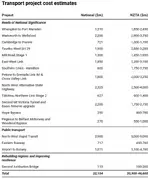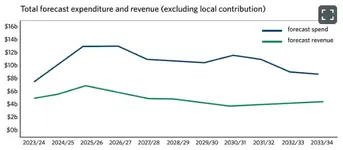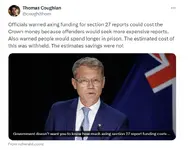The real generational debt is not using the Govt balance sheet and debt capacity to fix the real problems. Govt debt is a tool to get shit done.
The real debt cap is not fiscal, but productive capacity (material resources, workers etc). Use the govt books to expand those things.
You don't maintain a AAA credit rating if your economy and books are fragile. Nor do you get heavy interest from bond investors when floating long-term sovereign bonds to the market. S&P said NZ could borrow a further 30% of GDP ($120 billion) before they would look at downgrading.
Fucking enormous borrowing capacity and you mugs want to sit back, curse the poor and penny pinch for a rainy day - when it's pouring! We have a multitude of things we need to invest in and we're just going to sit on our hands for the next 3 years. Lol.
Willis says Budget finances same as household's, telling MPs cuts needed when money's tight; S&P says NZ's finances not fragile & sees extra 30% of GDP of borrowing capacity; Huge demand for 2054 bond

thekaka.substack.com
I think Luxon & Willis are cowards, They are telling us the state of NZ is fragile, so they don't have to do anything. Coz they don't actually have any policy to fix anything.
Saying the economy and the books are fragile, is the easy way out. Just cut spending and sit on your hands.
If they were serious about 'the tough calls', they would review/expand the tax take to include CGT, Wealth or a land tax and remove tax from income tax. That way we could fund investment in infrastructure (~$200 billion deficit), health, education etc, whilst also paying down debt faster.
While I agree with most of what you've said, they have got some planned infrastructure..... it's just likely to cost one hell of a lot more than what they've said it would.....
Transport projects could cost twice as much as National estimated, leaving potential fiscal hole of $24b - NZTA
Delivering the
roads and public transport National campaigned on ahead of the October 2023 election could end up costing more than twice as much as the party said it would, leaving a potential fiscal hole of $24 billion.
The
Herald has seen a document
New Zealand Transport Agency Waka Kotahi (NZTA) prepared in late November that includes updated cost estimates for various transport projects.
NZTA estimated 17 projects could collectively cost between $30.9b and $46.6b.
National, which was accused by Labour before the election of
under-cooking its estimates, budgeted only $22.2b for the same projects.
NZTA’s upper estimate is a whopping $24.4b (110 per cent) above National’s, while its average estimate is $16.6b (75 per cent) higher.

The revelations come just days after Prime Minister Christoper Luxon used his
State of the Nation speech to accuse Labour of
underfunding its transport promises to the tune of $200b.
Transport Minister Simeon Brown recognised National’s costings were “well-debated” before the election.
He assured the party was cognisant of inflation, and used the most recent costings when it put its transport policy document together.

He wouldn’t comment on which projects would be prioritised, deprioritised or even cancelled in light of the costs likely being so much higher than anticipated.
“I am currently finalising the draft Government Policy Statement (GPS) on land transport as part of the coalition Government’s 100-day plan,” he said.
“The GPS will outline the Government’s priorities across transport, including how projects will be funded.”
The most expensive project identified by NZTA was the North-West Rapid Transit, estimated to cost between $5b and $9b - considerably more than National’s estimated $2.9b.
NZTA put the cost of the Warkworth to Wellsford “road of national significance” at between $2.9b and $3.75b - up from the $2.2b pencilled in by National.
It expected the Second Mount Victoria Tunnel and Basin Reserve upgrade to cost up to $2.75b - in line with National’s estimate, and Mill Road Stage 1 up to $1.95b.
Green Party transport spokeswoman Julie Anne Genter accused National of being “untrustworthy and irresponsible”.
“Their campaign promises were not deliverable,” she said.
“They’re promising people heaps more infrastructure with less taxes - that’s not possible… They have no way to pay for these roads. User charges are not going to pay for these roads.”
NZTA also included a few estimates in its document for “recovery and resilience projects”, which National didn’t include costings for in its pre-election policy document.
These included for State Highway 1 Brynderwyns to Port Marsden ($2.8b-$2.4b), the Hawke’s Bay Expressway ($0.85b-$1.2b), SH5 Napier to Taupō ($2.3b-$6b) and SH2 Napier to Gisborne ($1b-$1.8b).
Meanwhile, NZTA didn’t put figures on a couple of smaller projects National mentioned in its policy document.
NZTA cautioned its costings were “preliminary” and individual project estimates shouldn’t be quoted.
It explained the estimates were based on the “latest known project scope”, and said in many cases, projects have been inactive for two to six years. So, its starting point for some cost estimates were highly variable.
Nonetheless, for each project it inflated the last known business case to 2023 dollars, before adjusting the upper range for “scope uncertainty”.
It said while modelled costs help with planning, a number of other factors influence costs, including timing, future labour costs, consenting, market capacity and capability.
NZTA, in a separate (publicly available) briefing to the incoming transport minister, warned funding the transport system in a way that delivers what’s needed is an
“imminent challenge”.
It presented the new minister with a confronting graph that showed it would need to spend about twice as much as it expected to receive in revenue over the next decade.
The funding shortfall it identified was worth several billion dollars a year.

NZTA gets most of its funding from road-user chargers and fuel excise duties. It also borrows money and is sporadically allocated money by the Government to deliver specified projects.
While Brown is scrapping the Auckland Regional Fuel Tax, he is keen to broaden the types of mechanisms used to fund infrastructure.
He is supportive of using more public-private partnerships, value capture (which could include imposing rates on property owners that benefit from new infrastructure), tolls and congestion charging.
Again, Brown didn’t want to get into the details of how these tools might be used ahead of the draft GPS, which he said would be released “soon”.
“As Minister of Transport, I have already made a number of decisions to rein in the previous government’s reckless and unfunded spending commitments,” he said.
“This has included scrapping Auckland Light Rail, which was expected to cost up to $29b, and after six years and $228 million of spending, has failed to deliver even a metre of track.
“I also cancelled Let’s Get Wellington Moving, an expensive project that failed to deliver for the capital city.”
Jenée Tibshraeny is the Herald’s Wellington Business Editor, based in the Parliamentary press gallery. She specialises in government and Reserve Bank policymaking, economics and banking.
NZTA estimates National's transport plan includes a hole worth up to $24 billion.

www.nzherald.co.nz
Interesting that the Greens have criticised National for having a possible $25 billion hole in their transport plan but were happy with Labour's $200 billion hole in theirs.






